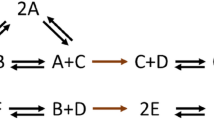Abstract
We consider a natural class of reaction networks which consist of reactions where either two species can inactivate each other (i.e., sequestration), or some species can be transformed into another (i.e., transmutation), in a way that gives rise to a feedback cycle. We completely characterize the capacity of multistationarity of these networks. This is especially interesting because such networks provide simple examples of “atoms of multistationarity”, i.e., minimal networks that can give rise to multiple positive steady states.



Similar content being viewed by others
Data Availability Statement
Data sharing not applicable to this article as no datasets were generated or analysed during the current study.
Notes
Throughout this article we use the convention that species names are in the upper case while their concentrations are the corresponding lower case letter. For example, the concentrations of species \(X_1,\ldots , X_n\), are denoted \(x_1,\ldots , x_n\).
References
Angeli D, Ferrell JE, Sontag ED (2004) Detection of multistability, bifurcations, and hysteresis in a large class of biological positive-feedback systems. Proc Natl Acad Sci 101(7):1822–1827
Angeli D, De Leenheer P, Sontag E (2010) Graph-theoretic characterizations of monotonicity of chemical networks in reaction coordinates. J Math Biol 61(4):581–616
Bai X, Pantea C, Parajdi L, Voitiuk G, Yu PY. Cycles in mass-action networks and multistationarity (in preparation)
Banaji M, Craciun G (2009) Graph-theoretic approaches to injectivity and multiple equilibria in systems of interacting elements. Commun Math Sci 7(4):867–900
Banaji M, Craciun G (2010) Graph-theoretic criteria for injectivity and unique equilibria in general chemical reaction systems. Adv Appl Math 44(2):168–184
Banaji M, Pantea C (2016) Some results on injectivity and multistationarity in chemical reaction networks. SIAM J Appl Dyn Syst 15(2):807–869
Banaji M, Pantea C (2018) The inheritance of nondegenerate multistationarity in chemical reaction networks. SIAM J Appl Math 78(2):1105–1130
Banaji M, Donnell P, Baigent S (2007) P matrix properties, injectivity, and stability in chemical reaction systems. SIAM J Appl Math 67(6):1523–1547
Chen Y, Short C, Halász AM, Edwards JS (2013) The impact of high density receptor clusters on VEGF signaling. Electron Proc Theor Comput Sci 2013:37
Conradi C, Mincheva M (2017) Graph-theoretic analysis of multistationarity using degree theory. Math Comput Simul 133:76–90
Craciun G (2019) Polynomial dynamical systems, reaction networks, and toric differential inclusions. SIAM J Appl Algebra Geom 3:87–106
Craciun G, Feinberg M (2005) Multiple equilibria in complex chemical reaction networks: I. The injectivity property. SIAM J Appl Math 65(5):1526–1546
Craciun G, Feinberg M (2006) Multiple equilibria in complex chemical reaction networks: extensions to entrapped species models. IEE Proc Syst Biol 153(4):179–186
Craciun G, Tang Y, Feinberg M (2006) Understanding bistability in complex enzyme-driven reaction networks. Proc Natl Acad Sci 103(23):8697–8702
Craciun G, Dickenstein A, Shiu A, Sturmfels B (2009) Toric dynamical systems. J Symb Comput 44(11):1551–1565
Craciun G, Pantea C, Sontag E (2011) Graph-theoretic analysis of multistability and monotonicity for biochemical reaction networks. Des Anal Biomol Circuits 63–72
Craciun G, Mincheva M, Pantea C, Yu PY (2021) A graph-theoretic condition for delay stability of reaction systems. arXiv:2105.07321
Donnell P, Banaji M, Marginean A, Pantea C (2014) CoNtRol: an open source framework for the analysis of chemical reaction networks. Bioinformatics 30(11)
Feinberg M (2019) Foundations of chemical reaction network theory. Springer, Switzerland
Feliu E, Wiuf C (2013) Simplifying biochemical models with intermediate species. J R Soc Interface 10(87):20130484
Félix B, Shiu A, Woodstock Z (2016) Analyzing multistationarity in chemical reaction networks using the determinant optimization method. Appl Math Comput 287:60–73
Ferrell JE Jr (2002) Self-perpetuating states in signal transduction: positive feedback, double-negative feedback and bistability. Curr Opin Cell Biol 14(2):140–148
Horn F (1972) Necessary and sufficient conditions for complex balancing in chemical kinetics. Arch Ration Mech Anal 49(3):172–186
Horn F, Jackson R (1972) General mass action kinetics. Arch Ration Mech Anal 47(2):81–116
Joshi B (2013) Complete characterization by multistationarity of fully open networks with one non-flow reaction. Appl Math Comput 219:6931–6945
Joshi B, Shiu A (2012) Simplifying the Jacobian Criterion for precluding multistationarity in chemical reaction networks. SIAM J Appl Math 72(3):857–876
Joshi B, Shiu A (2013) Atoms of multistationarity in chemical reaction networks. J Math Chem 51(1):153–178
Joshi B, Shiu A (2015) A survey of methods for deciding whether a reaction network is multistationary. “Chemical Dynamics’’ - special issue of Mathematical Modelling of Natural Phenomena 10(5):47–67
Joshi B, Shiu A (2017) Which small reaction networks are multistationary? SIAM J Appl Dyn Syst 16(2):802–833
Mac Gabhann F, Popel A (2007) Dimerization of VEGF receptors and implications for signal transduction: a computational study. Biophys Chem 128:125–39
Mincheva M, Roussel MR (2007) Graph-theoretic methods for the analysis of chemical and biochemical networks. I. Multistability and oscillations in ordinary differential equation models. J Math Biol 55(1):61–86
Müller S, Feliu E, Regensburger G, Conradi C, Shiu A, Dickenstein A (2016) Sign conditions for injectivity of generalized polynomial maps with applications to chemical reaction networks and real algebraic geometry. Found Comput Math 16(1):69–97
Pantea C (2012) On the persistence and global stability of mass-action systems. SIAM J Math Anal 44(3):1636–1673
Regan ER, Aird WC (2012) Dynamical systems approach to endothelial heterogeneity. Circ Res 111(1):110–130
Shinar G, Feinberg M (2012) Concordant chemical reaction networks. Math Biosci 240:92–113
Tang X, Wang J (2021) Bistability of sequestration networks. Discret Contin Dyn Syst B 26(3):1337–1357
Wiuf C, Feliu E (2013) Power-law kinetics and determinant criteria for the preclusion of multistationarity in networks of interacting species. SIAM J Appl Dyn Syst 12(4):1685–1721
Yu PY, Craciun G (2018) Mathematical analysis of chemical reaction systems. Isr J Chem 58(6–7):733–741
Acknowledgements
We thank the reviewers for their insightful comments, and AIM for hosting SQuaRE workshops where we initiated the study in this paper.
Author information
Authors and Affiliations
Corresponding author
Additional information
Publisher's Note
Springer Nature remains neutral with regard to jurisdictional claims in published maps and institutional affiliations.
Rights and permissions
About this article
Cite this article
Craciun, G., Joshi, B., Pantea, C. et al. Multistationarity in Cyclic Sequestration-Transmutation Networks. Bull Math Biol 84, 65 (2022). https://doi.org/10.1007/s11538-022-01021-7
Received:
Accepted:
Published:
DOI: https://doi.org/10.1007/s11538-022-01021-7




